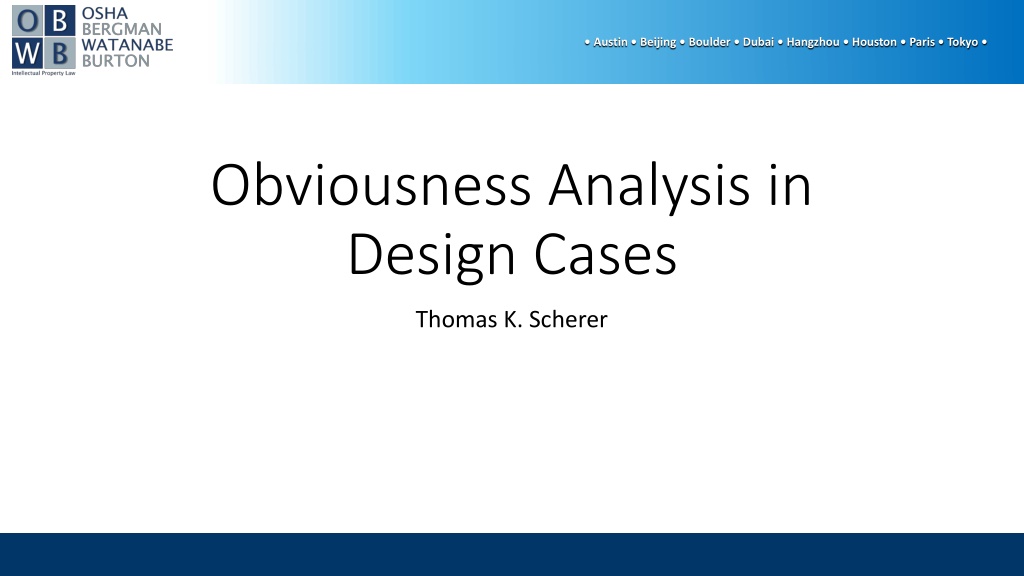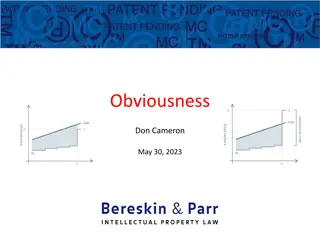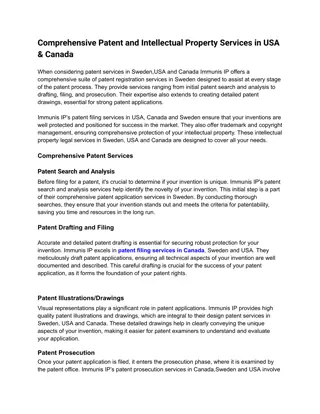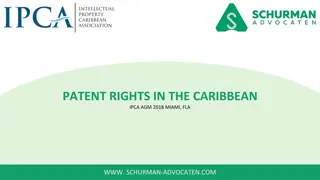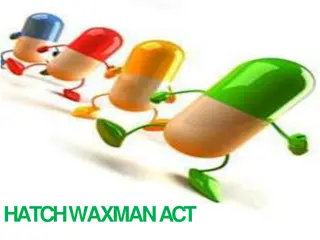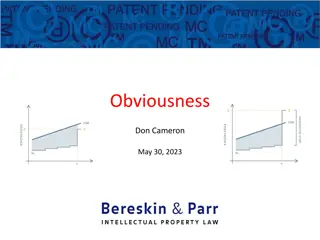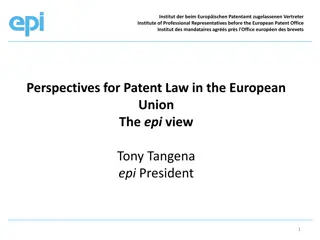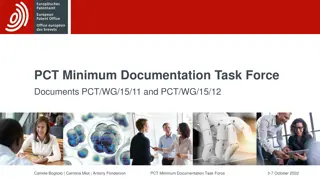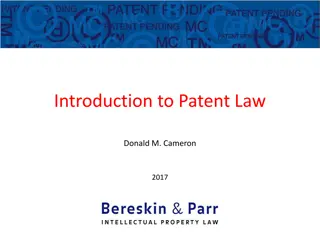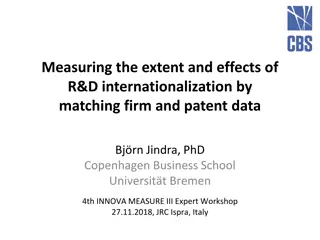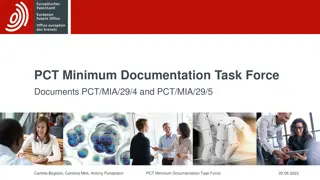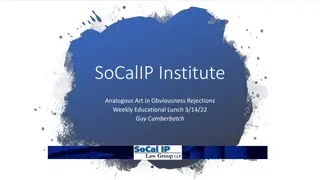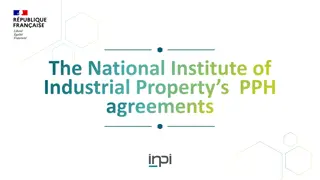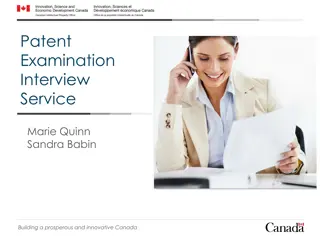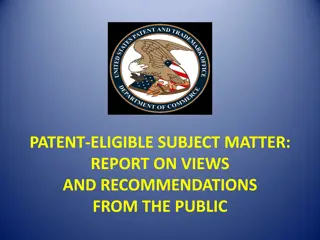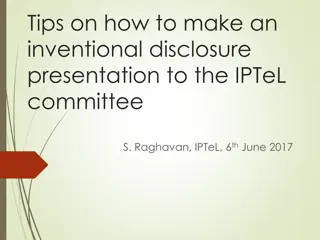Obviousness Analysis in Design Patent Case
The U.S. Court of Appeals for the Federal Circuit has granted en banc rehearing of a patent case involving automotive body repair parts. This ruling may impact how obviousness is determined in design patents, potentially lowering the bar for obviousness and eliminating a test that has been used since 1982. The case involves a dispute over a front fender design patent between LKQ Corporation and General Motors. LKQ challenged the validity of the patent, and the Patent Trial and Appeal Board upheld its validity, leading to an appeal by LKQ.
Download Presentation

Please find below an Image/Link to download the presentation.
The content on the website is provided AS IS for your information and personal use only. It may not be sold, licensed, or shared on other websites without obtaining consent from the author.If you encounter any issues during the download, it is possible that the publisher has removed the file from their server.
You are allowed to download the files provided on this website for personal or commercial use, subject to the condition that they are used lawfully. All files are the property of their respective owners.
The content on the website is provided AS IS for your information and personal use only. It may not be sold, licensed, or shared on other websites without obtaining consent from the author.
E N D
Presentation Transcript
Austin Beijing Boulder Dubai Hangzhou Houston Paris Tokyo Obviousness Analysis in Design Cases Thomas K. Scherer
Case Cite LKQ Corp. et al. v. GM Global Technology Operations LLC Petitioners, LKQ Corporation and Keystone Automotive Industries, Inc. (collectively, LKQ ) sell automotive body repair parts LKQ was granted a license by General Motors ( GM ) to many of GM s design patents
Rehearing Granted The U.S. Court of Appeals for the Federal Circuit (CAFC) has decided to grant en banc rehearing of a patent case All twelve (12) of the sitting judges of the CAFC will hear and rule on the case The en banc ruling may potentially change the way obviousness is determined in design patents The bar for obviousness could be lowered and a test that has been applied to design patents since 1982 could be eliminated
Rehearing Granted Among various licensed designs was U.S. Patent No. D797,625 ( the 625 patent ), which claims the appearance of a front fender for a vehicle The license expired in February 2022 Thereafter, GM asserted that the replacement parts being sold by LKQ were infringing GM s patents The lawsuit included the 625 patent
Background In response, LKQ petitioned the Patent Trial and Appeal Board (PTAB) for an inter partes review of the 625 patent LKQ asserted that the 625 patent was invalid as anticipated by U.S. Patent No. D773,370 ( Lian ) PTAB was unconvinced by LKQ s arguments and subsequently concluded that the 625 patent remained valid LKQ appealed the decision
Prior Ruling LKQ took issue with two aspects of the PTAB s decision The first challenge involved the PTAB s method of determining anticipation of the 625 patent Second, as GM is a car manufacturer, LKQ disagreed with the PTAB s finding that the ordinary observer of the design would include only retail consumers looking to buy replacement fenders and commercial replacement part buyers
Prior Ruling LKQ took issue with two aspects of the PTAB s decision In the second challenge, LKQ argued that the tests used by the PTAB to determine obviousness in design patents referred to as the Rosen-Durling tests were no longer valid since they had been implicitly overruled by the Supreme Court s decision in KSR Int l Co. v. Teleflex Inc., ( KSR )
Question Presented to CAFC KSR made obviousness easier to prove Replacing the rigid teaching, suggestion, and motivation ( TSM ) test with a more flexible standard for analyzing obviousness When assessing patentability of claims under KSR Considerations such as: common sense, hindsight, and level of ordinary skill of a person skilled in the art of the invention are permitted The question presented to the CAFC is: What is the proper test for the determination of obviousness in design patents?
Obviousness Analysis In the inter partes review, the PTAB applied the established and controlling Rosen-Durling tests for obviousness Rosen has two criteria for design patent obviousness First, there must be a primary reference that is basically the same as the claimed design to support a holding of obviousness Second, if a sufficient primary reference exists, the court must consider whether an ordinary designer would have modified the primary reference to achieve the claimed design
Obviousness Analysis In the inter partes review, the PTAB applied the established and controlling Rosen-Durling tests for obviousness Durling contributed an additional condition Secondary references may only be used to modify the primary reference if the two references are so related that the appearance of certain ornamental features in one would suggest the application of those features to the other
Obviousness Analysis The PTAB ruled: LKQ failed to identify a sufficient primary reference and, thus, failed to prove obviousness of the claimed design of the 625 patent under the Rosen-Durling test for obviousness LKQ appealed the PTAB decision to the CAFC arguing that the Rosen-Durling tests were implicitly overruled by KSR
Appeal LKQ contended: The analysis and reasoning of KSR should have been applied to the obviousness analysis of the 625 patent GM asserted: LKQ forfeited this argument by not raising it before the PTAB, and KSR does not overrule Rosen or Durling
Appeal The CAFC s initial opinion stated: Since KSR was decided by the U.S. Supreme Court, more than fifty appeals involving obviousness of design patents have been decided using the Rosen-Durling tests Of those appeals, only two cases raised the issue of the correctness of the current design obviousness guidelines in light of KSR
Appeal The three-judge panel of the CAFC concluded that they cannot overrule Rosen or Durling without a clear directive from the Supreme Court Ultimately, the court affirmed the PTAB s decision that LKQ failed to show that the 625 patent would have been obvious over the cited references based on the Rosen-Durling tests for obviousness of design patents
Request for Rehearing In response, LKQ petitioned the CAFC for a rehearing en banc requesting: Rosen and Durling be overruled and replaced with a test consistent with KSR The petition for rehearing en banc was granted in an order dated June 30, 2023
En Banc Rehearing In the order, the CAFC requested that LKQ and GM address several questions: For instance, does KSR overrule or abrogate Rosen and Durling? Further, if KSR neither overrules or abrogates Rosen and Durling, does KSR apply to design patents and should KSR be used to eliminate or modify the Rosen-Durling tests for design patents?
En Banc Rehearing In the order, the CAFC requested that LKQ and GM address several questions: Finally, if the Rosen-Durling tests are modified or eliminated, what test (or tests) should be used for evaluating design patent obviousness challenges moving forward? In addition to the briefs from LKQ and GM, the CAFC has invited briefs of amicus curiae, that is, briefs from interested non-parties to the case
Whats Next? The forthcoming ruling could have significant implications for design patent owners and their competitors seeking to invalidate design patents Any decision overruling Rosen-Durling may make it easier to invalidate design patents, which could reduce the value of obtaining a design patent in the first place
Whats Next? Additionally, obtaining a design patent could become far more challenging in the future Because the criteria for obviousness during examination of design patent applications would be broadened to coincide with the KSR criteria, if Rosen is overruled Doing so could allow Examiners to more easily reject design patent applications
Possible Outcomes If Rosen is overturned, the CAFC may decide to provide further guidance regarding the criteria for analyzing obviousness in design patents Alternatively, the CAFC may uphold the current rules and simply maintain the Rosen-Durling tests for obviousness analysis in design patents
Possible Outcomes This case has instantly caused much uncertainty in the field of design patents What is certain, however, is that all interested design patent owners and their competitors will be waiting for the CAFC s en banc decision. Further information to come when the en banc decision is actually issued Many amicus briefs (friend of the Court submissions) have been submitted by a variety of industry groups
Thank You Thomas K. Scherer Partner Osha Bergman Watanabe & Burton LLP P: 713-228-8600 | F: 713-228-8778 scherer@obwbip.com | www.obwbip.com
